|
|
| (1) Posted by Michael McDowell [Saturday, Mar 28, 2020 22:01] |
Keres two-mover
Paul Keres
Els Escacs a Catalunya 1934
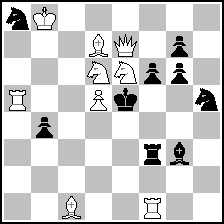 (= 9+9 ) (= 9+9 )
#2
1.Sb5 (>2.Sf4, Sec7)
1…Kxd5+ 2.Sd6
1…Kf5+ 2.Sec7
1…Ke4+ 2.Sf4
In The Problemist in 1974 Comins Mansfield mentioned a problem he had composed where the key gave three lateral flights allowing royal battery checks. Hermann Albrecht sent him the Keres, saying it was a complete anticipation. Mansfield noted that Keres had used an extra white rook.
Can anyone suggest Mansfield’s setting?
|
|
| (2) Posted by Hauke Reddmann [Sunday, Mar 29, 2020 16:41] |
To anyone who Keres (SCNR): The constructive problem is
that e3 must be guarded against 1.Sf4+ 2.Qe3#. Any guard
can interfere then, nailing the Ne6 down, thus Rf1. Another
possibility to split Sc7/Sf4 than the Bc1 I don't see at
the moment. Rotating is only possible in one direction,
but then the Pd5 would allow to swap moves (1.Sf4+ 2.Sb5)
in the rotated position. Maybe Mansfield had a different
matrix?
|
|
| (3) Posted by Zalmen Kornin [Sunday, Mar 29, 2020 17:20] |
Yes, e3 is the hot spot... I have already a draft without the wR, but with the serious issue of a repeated mating movement in two of the variatons. The double threat is also a drawback already inherent to Keres matrix.
|
|
| (4) Posted by Geoff Foster [Tuesday, Mar 31, 2020 01:16] |
It can be done with only one white rook, using just 13 units! The matrix is the same, with a slight twist. I won't put the diagram here, because some of you might still be working on this challenge, but it can be found in the databases. It is from 1944 and is not by Mansfield.
|
|
| (5) Posted by Hauke Reddmann [Tuesday, Mar 31, 2020 10:11] |
Good grief. Of course I had the right idea immediately...and
immediately canned it "because then X would defend".
OTB or elsewhere, I always fall for pins! (Hint, Hint :-)
|
|
| (6) Posted by Michael McDowell [Tuesday, Mar 31, 2020 16:28] |
A wonderful piece of construction! (and even some dual avoidance in a subsidiary variation).
So superior I'd say there's no need for "after Keres".
|
|
| (7) Posted by Zalmen Kornin [Tuesday, Mar 31, 2020 18:39]; edited by Zalmen Kornin [20-04-04] |
A most extraordinary find, a newer rendering a decade after the Keres. Thanks for that, Geoff.
Well, I'm not that quick in browsing the databases. ** Neither in mansfielding the matrix... We still need the second white Rook, here in a new function. And also: why Keres needed so many black Knights?!
(V)
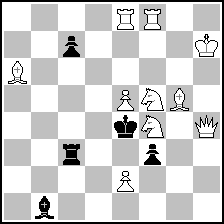 (= 10+5 ) (= 10+5 )
#2
* PS 4-iv-2020: An alternative setting, that i would prefer today, affords more mobility to the Queen, and a pair of attempts 1.Qf2/Qd8 each with double threat and a single refutation.
(Vi-v)
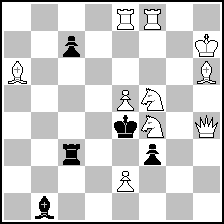 (= 10+5 ) (= 10+5 )
#2
|
|
| (8) Posted by Geoff Foster [Wednesday, Apr 1, 2020 00:33] |
Johannes Öhquist
Hamburger Morgenblatt 1944
 (= 9+4 ) (= 9+4 )
1.Sc4! (>2.Sg3,Sfd6)
1...Kxe4+ 2.Se5
1...Kxg4+ 2.Sg3
1...Kf3+ 2.Sfd6
(1...Be5 2.Sg3)
Johannes Wilhelm Öhquist (born December 6, 1861 in Slavyanka near Saint Petersburg, Russia, died October 15, 1949 Wolfach, Baden, Germany) was a Finnish civil servant, language teacher, art historian and politically active writer. He was also a chess player and problem composer.
|
|
| (9) Posted by Jacques Rotenberg [Wednesday, Apr 1, 2020 04:12] |
This seems to be an upgrade of a previous one :
Jozsef Szoghy
Debreceni Kereskedok es V.E. 1937
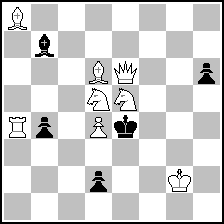 (= 8+5 ) (= 8+5 )
2#
1.Sxb4!
|
|
| (10) Posted by Frank Richter [Wednesday, Apr 1, 2020 08:18]; edited by Frank Richter [20-04-01] |
(deleted)
|
|
| (11) Posted by Zalmen Kornin [Wednesday, Apr 1, 2020 19:50]; edited by Zalmen Kornin [20-04-01] |
Great discovery too, very enlightening, Jacques, merci bien!
The Öhquist adds an extra flight given by the key, while the Szoghy had one flight already set on the diagram. So it will, I presume, also dispense with the use of "after ..." (or not?!)
|
|
| (12) Posted by Zalmen Kornin [Friday, Apr 3, 2020 17:29]; edited by Zalmen Kornin [20-04-04] |
(Vii) P Keres
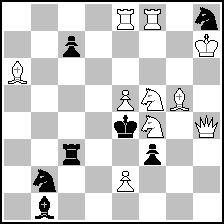 (= 10+7 ) (= 10+7 )
#2
Of course with the pair of black "horses" two extra (partial) defenses appears, anserewed each in a trivial way. Unfortunately they are also, these Knights, both fringy units, introduced with the only sake of producing the separation before the black King starts the flights ...
" ...shy one horse?
- no, you brought two too many. "
https://youtu.be/yCQKzLxAG_0
|
|
| (13) Posted by Zalmen Kornin [Sunday, Apr 5, 2020 16:02]; edited by Zalmen Kornin [20-04-05] |
There's the possibility of turning the Öhquist Knight to a Keres one, and then we will have the second of the pair of anti-dual defenses. Now I would not call that unit a fringe, because the Knight is also initially needed against the attempt 1.Bxb7 Nc6! Finally, I would also propose the return to the József Szöghy (Hungary, 1910-1993) general positioning, because it's more pleasant.
(V)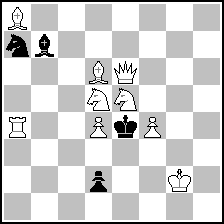 (= 9+4 ) (= 9+4 )
#2
1... Bd5/Nc6 2.Nf3/Nxc6# (1.Ra3?! Kxd4? 2.Ra4# virtual change, switchback. But 1...Bc8!)
|
|
| (14) Posted by Geoff Foster [Monday, Apr 6, 2020 00:30]; edited by Geoff Foster [20-04-06] |
Perhaps Öhquist decided against this setting because he didn't want a repetition of the 2.Sc6 mate (the repetition of 2.Sf3 is unavoidable).
|
|
| (15) Posted by Michael McDowell [Monday, Apr 6, 2020 07:57] |
Or because he didn't like the strategic mismatch between 1....Bd5, which involves dual avoidance, and 1...Sc6, which doesn't.
|
|
| (16) Posted by Zalmen Kornin [Monday, Apr 6, 2020 16:13] |
Maybe. And Keres wished the second Knight in a8 just to have the pair; and Szöghy preferred an inferior key just to avoid the black Knight and the extra white Pawn.
But the first question remains unwansered. The Mansfield setting.
|
|
| (17) Posted by Zalmen Kornin [Tuesday, Apr 7, 2020 11:14] |
PS ... well, it goes also without black Knight at all. And neither " a repetition of the 2.Sc6 mate", nor "strategic mismatch".
Vii/c 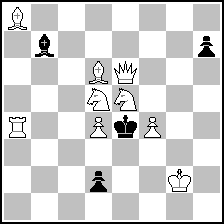 (= 9+4 ) (= 9+4 )
#2
* but for me it's ok also with +bNa7, -ph7. The Nc6 movement is repeated, but the frame is different. And the strategy is not matched, but it's a valid variation too.
|
|
| (18) Posted by Geoff Foster [Wednesday, Apr 8, 2020 00:55] |
Zalmen's latest setting is good.
Mansfield's setting must remain a mystery. Mansfield quoted the Keres problem on p.428 of the May 1974 issue of The Problemist, as follows:
Few composers can have had the distinction of having one of their efforts completely anticipated by a grandmaster of the game! Such a lot befell me recently. I made a problem in which the key gave three lateral flights allowing three discovered checks by the BK, with different replies. I thought this was quite new, and sent it to the Dutch Centenary tourney. Six weeks ago, I asked Herr Albrecht whether it was original. With his remarkable knowledge and courtesy he kindly sent me [D] (which incidentally uses an extra WR). He commented: "Your twoer is completely anticipated, but I doubt very much that the Dutch judges knew the appended problem. Possibly they found some hidden inaccuracy or just did not value your effort highly. After all, even the earlier setting nearly 40 years back won no distinction. Its authorship may surprise you but I can tell you I have filed no fewer than 35 twoers (his speciality) by Paul Keres. He even won a few prizes. The Soviet grandmaster (b 7-l-1916 at Navra, Estonia) started out with an interest in problems and correspondence chess when still at sohool in Pernau. He used to compete in both the correspondence and informal problem tourneys which Max Bluemich ran in his column in the Neue Leipziger Zeitung although he did not confine his activities to that medium alone".
|
|
| (19) Posted by Geoff Foster [Thursday, Apr 9, 2020 00:47] |
Mansfield sent his problem to the KNSB-100 Jubilee Tourney 1973 ("Koninklijke Nederlandse Schaakbond" is the Netherlands Chess Federation). The judge was E.Visserman and the award was published in Schakend Nederland in October 1973. However as the Mansfield problem was not in the award there is almost certainly no record of it. Does anyone have access to the relevant issue of Schakend Nederland?
|
|
No more posts |
MatPlus.Net  Forum Forum  Twomovers Twomovers  Keres two-mover Keres two-mover |
 ISC 2024
ISC 2024 Forum
Forum  Twomovers
Twomovers  Keres two-mover
Keres two-mover 


